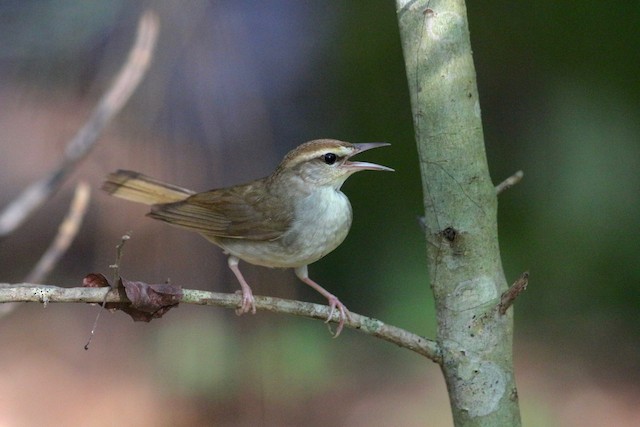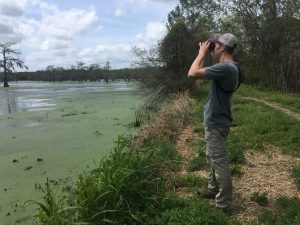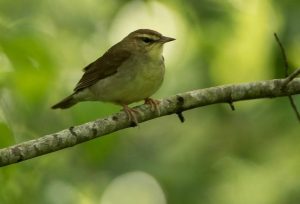By Eric Wallace

Swainson’s Warbler (CO Oscar Johnson – ML105518661)
For two years, Virginia Tech Conservation Management Institute technician Garrett Rhyne scoured far southwest Virginia collecting point-count data for breeding birds. Noticing the lack of information on the Swainson’s warbler, he’s now conducting a study of his own.
The sun is just beginning to rise when 21-year-old Garrett Rhyne pulls onto the shoulder of an old forest road in the backwoods of Smyth County. Stepping from the car, he gathers his gear and sets a timer. Scanning the forest, for the next five minutes he notes every birdsong and call he hears, as well as any birds he sees.
“I typically only visually identify around ten percent of the species I record, so it’s a lot of birding by ear,” explains Rhyne. In addition to trying to count all the individual birds within range, he needs to estimate approximate distances for each. “This is very different than regular birding. There’s no sitting in an area and enjoying it—you have to focus on getting down the information and doing so very quickly.”
When the timer dings, Rhyne rounds out his notes, gets back in the car, drives to the next predestined point, and repeats the process. By the end of the morning—9:30 or 10 a.m.—he’ll have gathered information from about 20 different locations. The remainder of the afternoon is spent scouting the following day’s route (the randomly generated ‘points’ occasionally correspond to a new housing development or a vanished roadway and must be replotted). From about mid-May to mid-July, collecting data in southwest Virginia is Rhyne’s day job.
What’s it all about? Employed by the Virginia Tech Conservation Management Institute (CMI), Rhyne is one of 15 technicians tasked with conducting the Commonwealth’s first comprehensive avian point-count study. Known as the Virginia Breeding Bird Point-Count (VABB-PC), the project began in 2017 and is a complimentary effort to the second Virginia Breeding Bird Atlas. While the VABBA2 focuses on collecting breeding distribution and behavioral data, project director Dr. Ashley Peele says the VABB-PC “uses a different set of survey methods to rigorously document population abundance and density for breeding bird species around the state.”
The information is important because, “abundance data tells us more about species distribution—not only are we learning where a species occurs, but in what numbers,” says Sergio Harding. A non-game bird conservation biologist with the Virginia Department of Wildlife Resources, Harding is the agency’s lead liaison for the project. He says that, ultimately, the statistics will “allow us to generate credible population estimates for many of our bird species” and produce correlative density maps that “reveal where in the state individual species are more and less abundant.”
 When combined with data collected by VABBA2 citizen-science volunteers, the study will provide a powerful tool for drawing conclusions—or, in many cases, suggesting better questions—about diversity, territoriality, and reactions to habitat loss, reforestation and existing conservation policies. In a big picture sense, Harding says it will help to “focus species conservation efforts on specific geographic areas where they are most in need of help, or where the biggest conservation outcome can be achieved.”
When combined with data collected by VABBA2 citizen-science volunteers, the study will provide a powerful tool for drawing conclusions—or, in many cases, suggesting better questions—about diversity, territoriality, and reactions to habitat loss, reforestation and existing conservation policies. In a big picture sense, Harding says it will help to “focus species conservation efforts on specific geographic areas where they are most in need of help, or where the biggest conservation outcome can be achieved.”
These goals are not lost on Rhyne. As a senior at VT working for CMI, he has expanded his point-count efforts to include a thesis study on the distribution and population density of a threatened species of songbird: the Swainson’s Warbler (Limnothlypis swainsonii).
The notion came to him after working on last year’s VABBA-PC in far southwest Virginia. There, Rhyne noticed a marked absence of the species, both in his counts and among eBird checklists. This contradicted previous BBA information. “I realized that there are many species that may be declining very fast, but, because so much attention is being paid to the big names—” like bald eagles or cerulean warblers— “we don’t seem to be noticing it,” he explains.
Working with Peele as his research advisor, Rhyne settled on the nondescript warbler.
The Swainson’s Warblers “prefer really thick understory and nest on the ground in the interior of Appalachian forests,” says Rhyne. However, “because most of our forests aren’t managed properly, that kind of habitat is rare in Virginia.” Furthermore, “when you do find it, it’s typically really hard to get to,” and will require bushwhacking cross-country and up super-steep hills. For these reasons, “the species has a very low detection rate.”
To find probable locations, Rhyne studied historical distribution data. After narrowing down his search to seven counties in far southwest Virginia, he began looking at satellite images of wintertime forests. Because rhododendrons keep their leaves, he relied on thickets as markers for dense undergrowth and subsequently plotted 100 survey points.
Throughout the spring and early summer, Rhyne has spent the majority of his free-time hiking into the deep woods to search for these elusive birds. When he finds them, he takes notes about their surroundings.
“Everywhere I go, I’m looking at habitat and recording characteristics,” he says. “If I can show what the birds prefer, the information will help us create better [species-specific] forest management practices.”
Thus far, the results have been astounding. Of the 50 survey points he’s completed, Rhyne has

CO Mary Catherine Miguez
discovered Swainson’s warblers on 21 of them, spotted more than 40 individuals, and become the first atlaser to confirm breeding. (For context, he says atlasers spotted about 10 individuals in all of 2017.)
Still, the best part has been the interactions.
“I started using audio playback as part of my survey protocol and quickly realized how territorial these birds are,” he says. “It’s so amazing, because here are these rarely seen, ultra-secretive birds, and they’re coming right up to me.”
Overall, Rhyne says he hopes the work will help to inspire a targeted conservation initiative in the vein of the Cerulean Warbler Appalachian Forestland Enhancement Project. There, distribution and abundance data led to the implementation of targeted forest management and enhancement projects in many areas of Appalachia.
“The cerulean warbler gets a lot of attention because it’s beautiful,” and, consequently, “there’s a bunch of habitat work going on,” says Rhyne. But for that to happen, “people had to go out and survey and figure out where the birds are—because you can’t just manage a random property; birds don’t work like that.”
According to Harding, the most critical aspect of developing any kind of conservation management strategy is figuring out where a given species is located and what kind of habitat they prefer. Though Virginia’s current Wildlife Action Plan (VAWAP) identifies “about 80 species with the greatest conservation needs,” Harding says the VDWR “doesn’t know much about some of those species”—including the Swainson’s Warbler. His hope is that the VABBA2 will continue to encourage highly specified studies like Rhyne’s, which will help him to revise the VAWAP by providing “better insight [with which to] develop targeted conservation strategies.”
According to Peele, that hope is swiftly becoming a reality. In addition to Rhyne’s work, she says she is “starting to see a wave of graduate students digging into our information and fashioning studies targeted at specific species or conservation issues.” With eBird making VABBA2 data available to anyone with an internet connection, she says the “usefulness of this information cannot be underestimated … We’re going to see some very, very exciting studies coming out of this dataset for a long time to come.”
~ Eric Wallace, VABBA2 Communications


